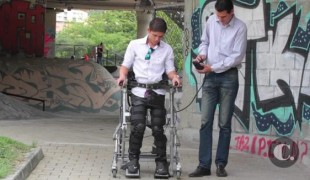- 7520
- 508
- 5
- 7
- 0
- Help Ukraine
About the solution
Isabel, Ailbhe’s sister, was born with Spina Bifida, and was always frustrated with the lack of options to personalize her wheelchair.
“I always say that I don’t want my chair to look like a medical device or a lump of metal and finally Ailbhe has found a way for me to be able to show it off as what I want people to see it as,” Isabel stated.
Ailbhe was always passionate about art and design. So after she took her degree, she created a range of personalized spoke guards for her sister.
“With the skills I had, I wanted to create something to make her feel more confident about her wheelchair so I created a range of customisable spoke-guards for the wheelchair which come in a range of different patterns and colours to match her outfits,” Ailbhe explained.
She named the project after her sister, and then founded their own company – Izzy Wheels.
The guards are available in several collections, depending on the theme, and it is possible for the user do create his own personal design.
More info: http://bit.ly/2eVQg6k
Adapted from: https://www.izzywheels.com/
https://youtu.be/bfWNOIVFBu4
This solution shall not include mention to the use of drugs, chemicals or biologicals (including food); invasive devices; offensive, commercial or inherently dangerous content. This solution was not medically validated. Proceed with caution! If you have any doubts, please consult with a health professional.
DISCLAIMER: This story was written by someone who is not the author of the solution, therefore please be advised that, although it was written with the utmost respect for the innovation and the innovator, there can be some incorrect statements. If you find any errors please contact the patient Innovation team via info@patient-innovation.com
-
-
451
-
0
-
6570

Engineer develops low cost exoskeleton inspired by a friend
WALKING: Walking
MOVING IN A WHEELCHAIR: Moving using a wheelchair.
Spinal Cord and Nerve Root Disorders
Accident
Cervical spinal cord injury/Tetraplegia
Walking Aid (wheelchair/walker/crutches)
Assistive Daily Life Device (to help ADL)
Muscle cramps or spasms
Stiffness or rigidity (difficulty moving)
Paralysis of the legs and lower body
Muscle weakness
Restoring mobility
Promoting self-management
Managing Neurological Disorders
Promoting inclusivity and social integration
Preventing (Vaccination, Protection, Falls, Research/Mapping)
Neurology
Orthopedics
Colombia
-
-
-
507
-
0
-
8663

Patient develops sand rider wheelchair
MOVING IN A WHEELCHAIR: Moving using a wheelchair.
CAREGIVING
Walking Aid (wheelchair/walker/crutches)
Restoring mobility
Promoting self-management
Promoting inclusivity and social integration
To implement a diagnostic tool
Maintaining Balance and Mobility
Caregiving Support
General and Family Medicine
Medical Genetics
Neurology
Orthopedics
Rheumatology
Aging
Mobility issues
Solutions for Disabled people
United States
-
-
-
506
-
0
-
7320

Scooter for disabled people
MOVING IN A WHEELCHAIR: Moving using a wheelchair.
CAREGIVING
Amyotrophic Lateral Sclerosis
Assistive Daily Life Device (to help ADL)
Walking Aid (wheelchair/walker/crutches)
Gait abnormalities (e.g., walking difficulties, unsteady gait)
Muscle cramps or spasms
Difficulty coordinating movements
Stiffness or rigidity (difficulty moving)
Paralysis of the legs and lower body
Muscle weakness
Fatigue
Restoring mobility
Promoting self-management
Rehabilitating After Stroke
Managing Neurological Disorders
Promoting inclusivity and social integration
Preventing (Vaccination, Protection, Falls, Research/Mapping)
Caregiving Support
Neurology
Orthopedics
Rheumatology
United States
-
 en
en